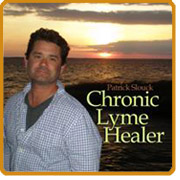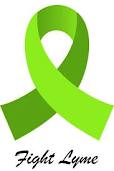










How to treat Lyme
 The symptoms of Lyme disease are quite variable and may include fever, headache, fatigue and a skin rash. If the infection is not treated, it can spread to the joints, heart and nervous system
The symptoms of Lyme disease are quite variable and may include fever, headache, fatigue and a skin rash. If the infection is not treated, it can spread to the joints, heart and nervous system
Lyme disease can be successfully treated with about four weeks of antibiotics; treatment is most successful during the early stages of infection.
The UC Davis study
 Swollen lymph nodes, or lymphadenopathy, is one of the hallmarks of Lyme disease, although it has been unclear why this occurs or how it affects the course of the disease. The UC Davis research team set out to explore in mice the mechanisms that cause the enlarged lymph nodes and to determine the nature of the resulting immune response.
Swollen lymph nodes, or lymphadenopathy, is one of the hallmarks of Lyme disease, although it has been unclear why this occurs or how it affects the course of the disease. The UC Davis research team set out to explore in mice the mechanisms that cause the enlarged lymph nodes and to determine the nature of the resulting immune response.
They found that when mice were infected with B. burgdorferi, these live spirochetes accumulated in the animals' lymph nodes. The lymph nodes responded with a strong, rapid accumulation of B cells, white blood cells that produce antibodies to fight infections. Also, the presence of B. burgdorferi caused the destruction of the distinct architecture of the lymph node that usually helps it to function normally.
While B cells accumulated in large numbers and made some specific antibodies against B. burgdorferi, they did not form "germinal centers," structures that are needed for the generation of highly functional and long-lived antibody responses.
"Overall, these findings suggest that B. burgdorferi hinder the immune system from generating a response that is fully functional and that can persist and protect after repeat infections," Baumgarth said. "Thus, the study might explain why people living in endemic areas can be repeatedly infected with these disease-causing spirochetes."
"The commonly known problem is that as the use of antibiotics becomes more and more widespread, the bacteria become more and more resistant."
Antibiotics for Lyme Disease

Why Antibiotics are used
 Antibiotics are used to cure early Lyme disease and to greatly reduce the risk of future complications. Antibiotics may also be used in the later stages of Lyme disease, when additional symptoms involving the skin, joints, nervous system, or heart may develop.
Antibiotics are used to cure early Lyme disease and to greatly reduce the risk of future complications. Antibiotics may also be used in the later stages of Lyme disease, when additional symptoms involving the skin, joints, nervous system, or heart may develop.
The type of antibiotic prescribed depends on your age, symptoms, and stage of Lyme disease. These medicines may be taken orally, as an injection, or through a vein (intravenous, or IV). The length of antibiotic treatment varies according to how bad the disease and your symptoms are, but treatment generally lasts less than 4 weeks.
Early Lyme disease
 • For people ages 8 and older, the number of days the antibiotic is used depends on the antibiotic and the severity of the infection.
• For people ages 8 and older, the number of days the antibiotic is used depends on the antibiotic and the severity of the infection. • Doxycycline should not be used to treat pregnant women or children younger than age 8.
• For children younger than age 8, amoxicillin is taken by mouth. Other medicines may be used if the child is allergic to amoxicillin.
Later stages of Lyme disease
 • For Lyme arthritis, oral antibiotics are usually taken for several weeks. If treatment with the oral antibiotic is not successful, an antibiotic may be given intravenously (IV).
• For Lyme arthritis, oral antibiotics are usually taken for several weeks. If treatment with the oral antibiotic is not successful, an antibiotic may be given intravenously (IV).
• For facial paralysis with no other nervous system problems, an oral antibiotic for several weeks is usually effective.
• For severe heart symptoms of Lyme disease or for other Lyme disease nervous system problems such as Lyme meningitis, IV antibiotics may be given.
Pregnant or nursing women
• Women who have early Lyme disease usually take an oral antibiotic for several weeks. Some doctors believe that pregnant women with early Lyme disease should receive IV antibiotics to prevent Lyme disease bacteria from crossing the protective membrane (placenta) that surrounds the developing fetus. But there is no proof such treatment is needed.
• In pregnant or nursing women who have late Lyme disease, IV antibiotics usually are used.
How Well It Works
 Antibiotics are most effective in helping cure Lyme disease when they are taken early in the course of the disease. Early treatment with antibiotics can help prevent future problems with arthritis, the heart, or the nervous system. But symptoms may not go away right away. Some symptoms may last for several weeks after treatment. This does not mean that the antibiotics were not successful, nor does it mean that you need additional antibiotic treatment.
Antibiotics are most effective in helping cure Lyme disease when they are taken early in the course of the disease. Early treatment with antibiotics can help prevent future problems with arthritis, the heart, or the nervous system. But symptoms may not go away right away. Some symptoms may last for several weeks after treatment. This does not mean that the antibiotics were not successful, nor does it mean that you need additional antibiotic treatment.Antibiotic treatment for early symptoms of chronic Lyme arthritis is usually very effective. Joints that have been badly damaged by Lyme arthritis may take a long time to get better after the infection has been cured, or they may not respond to treatment at all. A growing percentage of people in the United States continue to have symptoms of chronic Lyme arthritis after treatment with antibiotics.
Heart symptoms often begin to go away before antibiotics are given. If not, they usually respond to antibiotic therapy within days. Mild heart symptoms that may occur with early Lyme disease usually improve after treatment with oral amoxicillin or doxycycline for 21 to 30 days.
Symptoms of inflammation of the membrane surrounding the brain and spinal cord (Lyme meningitis) begin to improve by the second day of therapy and usually disappear after 7 to 10 days.
Side Effects
Common side effects of these antibiotics include:
• Nausea.
• Mild diarrhea.
• Allergic reaction.
• Secondary yeast infection in the intestines, vagina, or mouth (thrush).
DEPRESSION SEVERE DEPRESSION
Some people treated for early Lyme disease have brief episodes of headache, muscle and joint pain, and fatigue that may continue for an extended period of time after treatment. These symptoms usually go away on their own within 6 months and do not require further treatment.What To Think About

The dosage of antibiotic given and the duration of treatment should be based on your age and body weight, how bad the illness is, and how you respond to treatment. Doxycycline should be taken with plenty of fluids and not while you are lying down or right before bedtime.
If you get intravenous (IV) antibiotics, you may have weekly blood tests to check your white blood cell count. The IV antibiotic treatment may lead to low levels of white blood cells (called leukopenia) that can make it hard for you to fight infection.
With the exception of pregnant women and people with severe arthritis or heart problems, most people who have been exposed to ticks but do not have symptoms are not given antibiotics. Even in parts of the country where Lyme disease is known to occur often, the risk of getting Lyme disease is too small to warrant treatment before symptoms appear. Doxycycline is the drug of choice for treating early Lyme disease in people ages 8 and older. But it should not be given to pregnant women or to people who are allergic to tetracycline.
Long term Side effects of Antibiotics
Antibiotics only work against bacterial infections, not viruses.
The commonly known problem is that as the use of antibiotics becomes more and more widespread, the bacteria become more and more resistant. This is especially common when people quit their antibiotics prescription halfway through because they "feel fine"; some of the surviving bacteria then mutate into more resistant strains and spread into other people.
Other health problems from antibiotics
Let's look at some of the evidence showing the harmful effects of antibiotics.
Most of the negatives stem from the positive fact that antibiotics are so effective. The problem is that antibiotics are not as specific as we'd like: while they do destroy harmful bacteria, they also destroy beneficial bacteria.
Since one of the functions of intestinal bacteria is to aid in food digestion, it's no surprise that antibiotics can cause digestive problems. Diarrhea occurs in about 25% of patients receiving antibiotics. Until recently, the effect of antibiotics was thought to be temporary. Unfortunately, some new studies have begun to show that this is not necessarily the case. A study funded by the Finnish Academy found that the earlier estimates were too conservative, and that the effects of antibiotics on intestinal bacteria were visible even after a year. Surprisingly, they also discovered that using one type of antibiotic (such as penicillin or tetracycline) increases the resistance of bacteria to other types of antibiotics as well. The old idea of switching to a different antibiotic to avoid resistance doesn't seem so good after all.
A study from last year confirms these findings. Using a novel method of observing the human gut microbiota, the authors found that antibiotic treatment "influenced the abundance of about a third of the bacterial taxa in the gut, decreasing the taxonomic richness, diversity, and evenness of the community". While the conditions partly returned to normal after four weeks, several bacterial taxa failed to recover even after six months.
When it comes to Lyme disease it comes down to your immune system it’s just that simple. It also boils down to the type of immune system you have. If you have a type A Immune system or a type B immune system.
A type A immune system does not have a history of trauma and the immune system is not compromised their for they are sick but not yet chronic. A type B immune system is chronic and probably has a history of abuse or trauma associated with their past.
Type A immune systems can beat Lyme Type B are going to have a tough road ahead.
So how you treat Lyme would be totally different depending on your Immune system category you fell under.
So let’s go over the type A immune system first. Type A wants to get well and needs to get well and knows how to get well you just have to give the body the right tools at the right time to kill remove heal protect and build strong. You will need antibiotics you will need to stop when you get Candida and you will have to have a exit strategy from antibiotic treatment. If you just walk away cold turkey chances are it will come back you must follow a protocol similar to mine so that you’re building an immune system so great that nothing bad could flourish in your body. That requires exercise and juicing or blending your fruits and veggies and literally turning your food into medicine THERE IS A HUGE DIFFERENCE BETWEEN eating well and eating to heal. Health is mostly
H E A L the word tells on itself if you want to be healthy you fist must heal. So you constantly treat your disease even if you do not have the symptoms.
The next best piece of advice is fire your doctor if you didn’t get well under doctors care you are now on your own…..seek another way. The license on the wall prevents them from treating you so WAKE UP to the fact that the person who you seek to help you overcome this disease is not allowed to treat you the very protocol is against medical insurance procedures. Nobody should be on 3 antibiotics for 3 years and 2,500mg per day. That’s very wrong and very foolish of people to allow themselves to be told that’s the deal. YOU ARE RESPOCIBLE FOR WHAT GOES IN YOUR MOUTH. You must hire and fire medical practitioners to help you. It’s not a one and done my doctor said this and that’s the law. NO WAY must you be your own advocate. If your doctor doesn’t pay your mortgage or rent for you then he’s not your friend or family he’s just another person on your path of life and you are free to pay his mortgage or rent if you want with your health care and that’s your business but that’s the type of relationship you have YOU PAY YOUR DOCTORS RENT they dont pay yours if the treatment doesn’t work you still pay his or her rent so…..WAKE UP. Healthcare is a business so make it your business to be seeking health and wellness not paying rent on other person’s dreams.
A health practitioner would tell you straight up I want sick people and lots of them for a long period of time until I retire. That’s sounds like a very good plan to me. Problem is that’s not consistent with your wants and desires. SO WAKE UP. It’s just that simple the very drug that will be prescribed to you by definition means against life. ANTIBIOTIC means against life. Anti = against. Biotic = life….. Is it starting to make sense now?
Now let’s talk about the type B immune system this part is the hard part and I have over time actually been able to witness a pattern that kinda explained the whole situation.
The problem with chronic health when trauma is in the mix NOTHING UNDER THE SUN SEEMS TO WORK. And you will hear that over and over again from the individual that has a compromised immune system “I have tried everything nothing seems to work” They are correct they have tried JUST ABOUT EVERYTHING but the actual type of healing that replaces the cell structure that was imprinted with that toxic trauma. They have tried plenty of things that go in the mouth but not the thing that actually removes the shame and the guilt associated with the trauma. They don’t know that their fight or flight response is stuck on the on position. The autonomic nervous system is actually telling every system of body 24/365 please be on high alert we are under attack. a type B immune system doesn’t process food or nutrition like a type A immune system. That because a type B immune system uses food as FUEL to fight or flight the common cold doesn’t get the nutrients and vitamins to heal because the immune stem isn’t even a consideration HEY WE GOT A PROBLEM… THERE IS A REAL PROBLEM HERE this big bad thing is trying to hurt us. In that situation your body doesn’t need to help that little baby common cold it needs to convert the food into fuel to fight or flight.
This is why people who have a chronic health condition are usually under stress totally anxiety ridden and always seem to be on the run and totally fatigued from the constant never ender battle that is going on. Its like a car in 3rd gear going 65 miles per hour eventually its going to break down and that’s how type Bs get a chronic disease they simple have a compromised immune system that has a toxic cell structure.
So what the fix? ….good question the healing comes from the SPIRIT side of mind body spirit. We all agree that there is such a thing as the mind body and spirit. Well it’s the spirit that does the healing and turns the fight or flight response off. I have developed a very successfully technique for healing that part of the brain and it involves NLP, guided meditation and hypnotherapy.
The problem is there is no drug or herb that will detox shame and removes trauma from ones cell structure or the horrible terror the Amygdala is holding in their subconscious.
But for ever system of your body there is a type of medicine and a type B immune system is healed through a type of medicine that is actually connected to the sprit…..the same sprit of that mind body spirit concept.
IF YOU HAVE TRAUMA AND LYME
Please look into the Lyme Healer, Patrick has helped several chronically ill individuals over the years and has changed lives in literally one session. If your fight or Flight system is holding your immune system hostage Patrick can help with that.

Click here to go to the Lyme healer page
Herbastat Herpes Cure | Herbal Treatments | Herbal Articles
This statement has not been evaluated by the FDA. This product is not intended to diagnose, treat, cure, or prevent any disease.
DISCLAIMER
The information provided on this Site is for educational purposes only. Please consult a physician before beginning any treatment program or making any adjustments in your health care, diet, and /or lifestyle. Do not remove yourself from any prescribed medications or treatments without consulting your doctor. Any and all dietary supplements or nutritional products discussed on this Site are not FDA-approved and are not intended to diagnose, treat, prevent, or cure any disease.
The information contained in this website is for general information purposes only. While we endeavor to keep the information up to date and correct, we make no representations or warranties of any kind, express or implied. . None of the dietary supplements or nutritional products discussed on this Site are FDA-approved, and they are not intended to diagnose, prevent, treat, or cure any disease or illness.
This Site and its services are for consumer educational use only. Nothing contained in this Site is or should be considered, or used as a substitute for, medical advice, diagnosis, or treatment. This site and its services do not constitute the practice of medicine. Users should always seek the advice of a physician with any questions regarding their health or medical conditions. Never disregard, avoid, or delay obtaining medical advice or following the advice of a physician because of something you have seen or read on this Site.
Antiviral herbs | Candida | Lyme info | Chronic lyme | Herpes | Herpes info | HSV | Lyme Disease | Herbs for dogs | Herbal Company | Viral infection | Healing lyme | Stress | Dealing with herpes
